
(THINKING IN CIRCLES)
 | "The best way to learn how to get somewhere is to start thinking in circles.... |
| "Catch this dizzy dame!" |  |
 | "Don't be nervous, Lou! OK. Here's a circle. It has a center and an outside, called the CIRCUMFERENCE." | 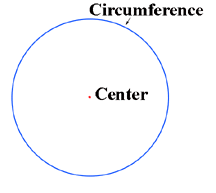 |
| "Now, let's divide the circumference into parts. (Each part is called an ARC.) Divide it into 2 equal parts, and what do you have? Two equal arcs called SEMI-CIRCLES. And if you divide it into four equal arcs, each arc is a 'quarter circle' or 'QUADRANT.' Now comes the fancy part: divide the circumference into 360 equal arcs, and each arc is called a DEGREE. So how many degrees is a semi-circle? How many degrees is a quadrant?" | 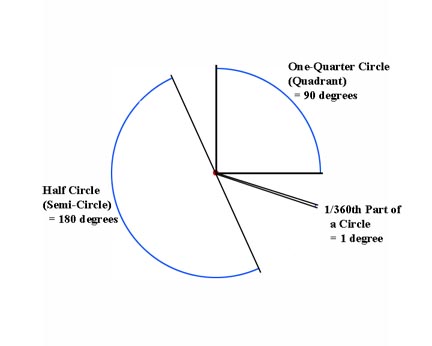 |
 | "Now suppose we want to number each of the 360 degrees...." |
 | "How about 'first degree', 'second degree' and then the third one could be 'the third degree'! (Heh heh!)" | 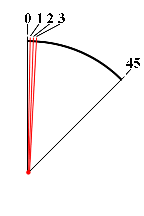 |
 | "Once again, Lou, you've hit it on the head. But 'third' from where? Some place on the circle has to be called the beginning, that is, called zero degrees. And then you can start counting, so every degree has a number. Notice that '0' is the same as '360' because you've gotten back to where you started. That's the way it is when you go around in a circle!" | 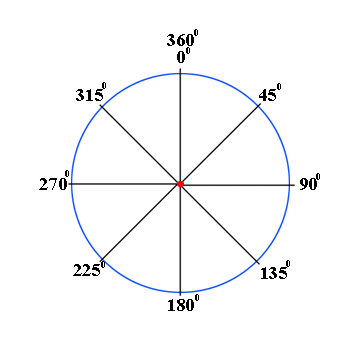 |
 | "Now, let's orient the circle so that the line going from the center of the circle to the '0' (or 360) is pointing North. (Do you know what NORTH means, LOU?!) Then the '90' points to the East, '180' to the South, '270' to the West, and so on. That system of stating direction according to the number of degrees clockwise from the zero is known as the AZIMUTH system! And there's a special name for the circle with its radiating lines and the directions marked on it. It's called a COMPASS ROSE!" | 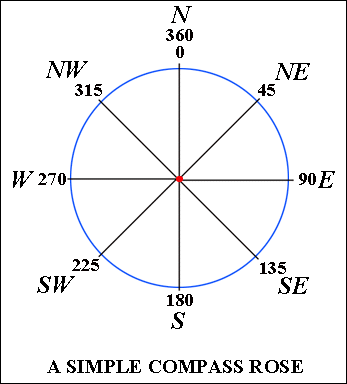 |
 | "But I see on the compass rose that 45 is called 'northeast' (NE), 135 is 'southeast' (SE), etc. That's how I'm used to giving directions! Names, not numbers!" |
 | "Those are called COMPASS QUADRANT BEARINGS and are also be shown on a compass rose! But compass quadrant bearings can also have numbers! North, south, east and west, and northeast, southeast, and so on are OK as names without numbers, but all the directions between them do better with numbers attached! For example, take the azimuth 137 degrees. It becomes south 43 degrees east (S 43 E). The table shows some more equivalents. Except for 'due' north ('due' means 'exactly'), due east, due west and due south, compass quadrant bearings are always given as so many degrees east or west of north or south!" |
| AZIMUTH | 0 | 27 | 93 | 178 | 185 | 270 | 283 | 350 | |
| COMPASS QUADRANT BEARING | N | N 27 E | S 87 E | S 2 E | S 5 W | W | N 77 W | N 10 W |
 | "Now you try it Lou! Where I've given you azimuths (in RED), you give me compass quadrant bearings; and where I've given you compass quadrant bearings (in GREEN, you give me the azimuths!" |
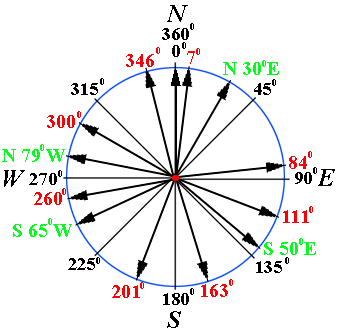
 | "OK, let's put our compass rose on a map! One that shows the villages of Luluville and Louberg and the larger market town of Ipple. AND VERY IMPORTANT, LOU: notice that on the map, the North arrow points towards the top of the map! That's the way it is on most maps, even if they don't show a North arrow. You can assume that the top is north unless the map shows a North arrow pointing a different way!" | 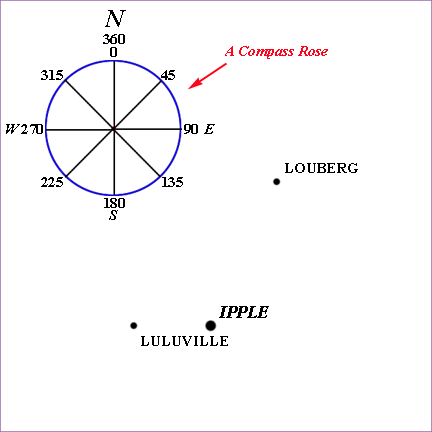 |
| "And the top of the mornin' to you too! Where'd ya get those names from?" |  |
 | "Concentrate, Lou! OK? Back to direction. As we said, to know which way to go from one place to another, all you have to do is give its azimuth or its compass quadrant bearing. For example, the BEARING (direction) from Luluville to Louberg is 45 degrees. That is, the line from Luluville to Louberg trends in the same direction as the line from the center of the compass rose to the 45 degree mark. Or, also as we said, we can call it N 45 E!" | 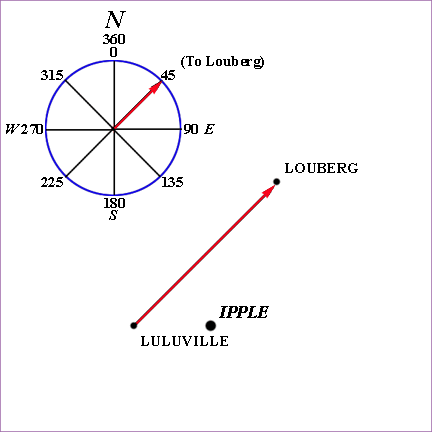 |
 | "Let's see if you understand! Here's some easy ones - what's the bearing (as an azimuth and also as a compass quadrant bearing) from Louberg to Luluville? From Luluville to Ipple? Now, how about this - can you estimate the bearing from Ipple to Louberg? From Louberg to Ipple?" |  |
 | "Great! So I know the direction from one place to another on a map! But there I am standing in Luluville with my map. I know the direction to Louberg is 45 degrees or N 45 E. But I don't see any signposts saying '45 degrees, this way'! What good does reading the map do me?!" |
 | "Here's one way! First, suppose there's a feature you can see on the map that you can also see from where you are standing in Luluville. It could be a road, a building, a river, the top of a hill.... For example, suppose from where you are standing you can see the bridge (shown in GREEN where Highway 101 crosses the River Taff. Now look at the map. Draw a line from where you are to the bridge (the short, RED arrow). Now see which bearing on the compass rose is parallel to that line. It's about 78 degrees (N 78 E). So, the angle between the bearing for the bridge (78 degrees or (N 78 E) and for Louberg (45 degrees or N 45 E) is about 33 degrees (78 minus 45). Now all you have to do is face the bridge, turn about 33 degrees counterclockwise, and start walking!" |  |
 | "These boots are made for walkin', I suppose!" |
 | "Why not?! Let's try you out. Suppose you were in Louberg and wanted to go to Luluville. Suppose from where you're standing you can see where Highway 101 takes its sharp bend. What's the approximate bearing (azimuth and compass quadrant) from you to the highway bend? About how many degrees would you turn to start walking towards Luluville? And from facing the bend would you turn clockwise or counterclockwise?" | 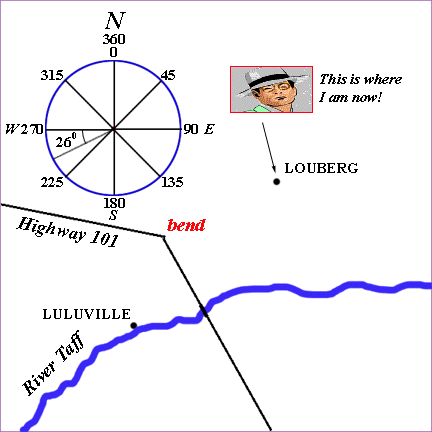 |
 | "OK, I got that. But isn't there an easier way that doesn't involve estimating angles?" |
 | "You could use a COMPASS!" | 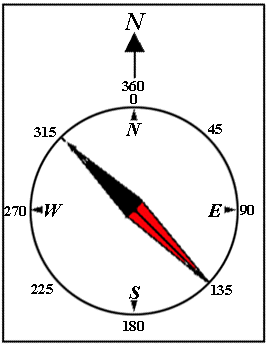 |
 | 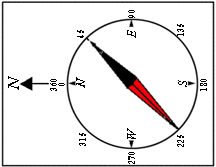 |
| ||
| DIAGRAM A | DIAGRAM B | |||
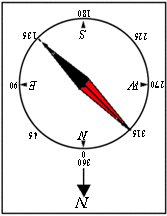 |  | |||
| DIAGRAM C | DIAGRAM D |
 | "The black end of the needle points towards MAGNETIC NORTH! REMEMBER! NORTH AND MAGNETIC NORTH ARE NOT USUALLY IN THE SAME DIRECTION! You have to take into account the angle between true north and magnetic north! That angle is called the MAGNETIC DECLINATION!" | 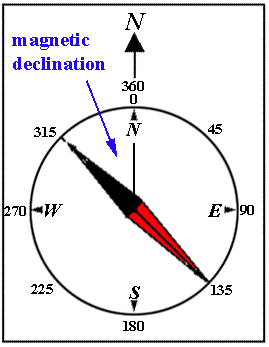 |
 | "Seems crazy to me! So what good are all the directions on the face of the compass??!! Looks like they can point in any direction!!" |
 | "Keep the faith, Lou! I'm gonna show ya!! Let's look at our Luluville-Louberg map again. This time, instead of showing the whole compass rose, the map just shows TRUE NORTH (N), MAGNETIC NORTH (MN) and the MAGNETIC DECLINATION. I've added a green arrow to show where you want to go - from Louberg to Luluville!" | 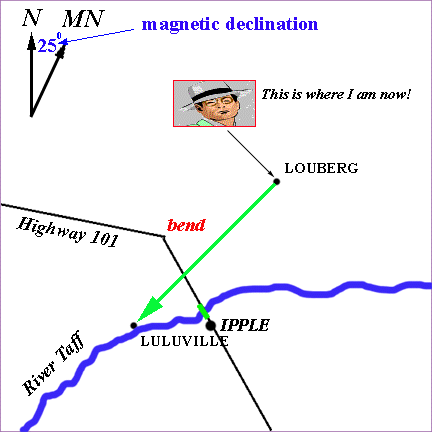 |
 | "OK, you're standing in Louberg. You place the map on a more or less flat, level surface. You then place the compass on top of the map. The black end of the compass needle points to magnetic north. That's the only thing you know is pointing in the right direction. The N and the MN on the map are just pointing the way they are because of how you happened to put down the map. The same holds true for the directions on the face of the compass. Don't forget, the needle floats free of the face of the compass. The directions marked on face of the compass just point the way they do because of how you happened to set the compass down!" | 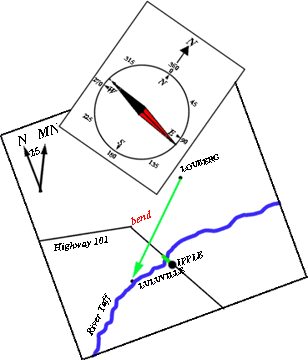 |
 | "So you need to make the directions on the map and on the face of the compass mean something. What you do is place the compass on the map so that the 'N' on the face of the compass is parallel to the north arrow 'N' on the map. (If the top of the map is north, as it is for most maps, then the top (north) edge of the compass is parallel to the top (north edge) of the map.) Then, you rotate both the map and the compass together until the Magnetic North (MN) arrow on the map points in the same direction as the black end of the compass needle. The black end of the needle now points to 25 degrees (N25 E). (That's the magnetic declination.) Now, both the map and the compass are oriented properly. That is, everything is pointed towards where it says it's pointed: the North arrows on the map and on the compass face point true north; the black end of the needle points to 25 degrees, which is the direction of magnetic north." |  |
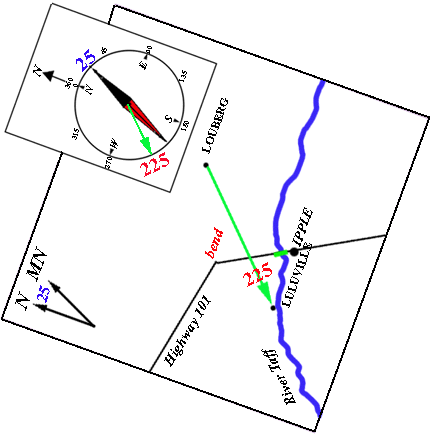 | "Now, we look to see what direction on the compass rose is pointing in the same direction as the green arrow from Louberg to Luluville. It turns out to be 225 degrees (S 45 W). In the diagram, I've drawn a short green arrow on the compass rose to show you that that direction is indeed parallel to the green arrow on the map. So, Lou, all you have to do to get to Luluville, is to make sure that when you start off (and keep checking as you go along) the black end of the compass needle points to 25 (N 25 E) and you head towards 225 degrees (S 45 W) as shown on the compass face." |  |
 | "I feel positively empowered! Now, with a map, I can find my way anywhere! Especially to Leo's Treasure Trove!" |
| "You've made good progress, Lou! if you've already learned about DISTANCE, ELEVATION, and LONGITUDE AND LATITUDE you're ready indeed to head for LEO'S TREASURE TROVE!" |  |